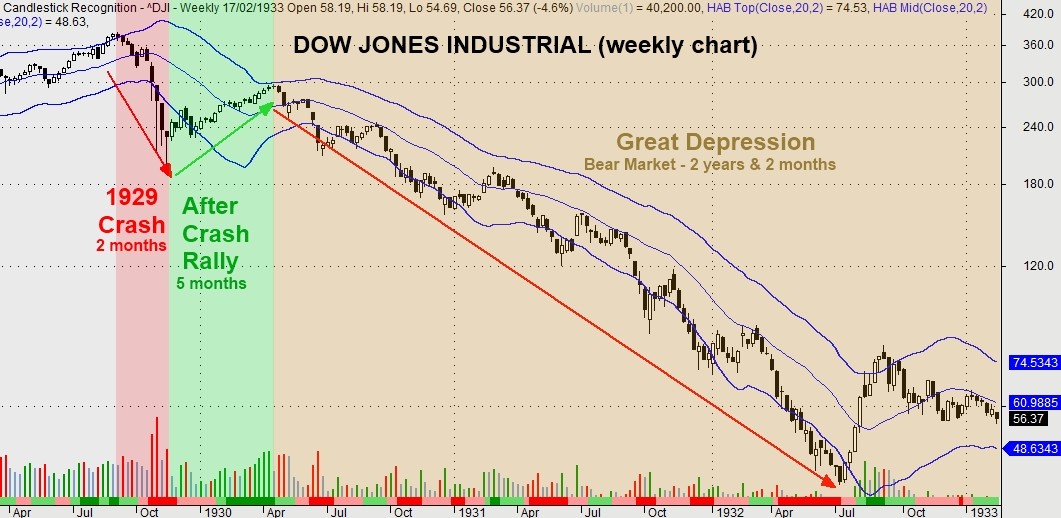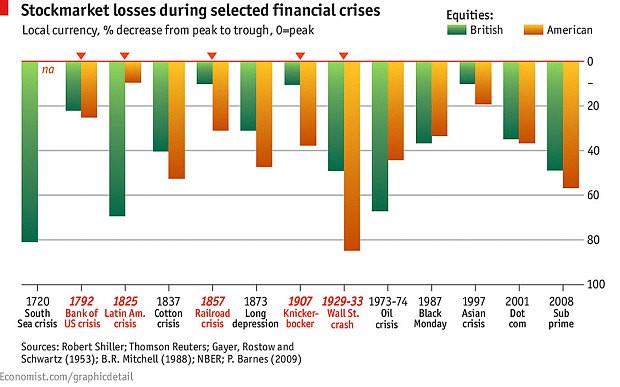Stock Market History Stock Market Crashes & Market History
Post on: 14 Июнь, 2015 No Comment

The Stock Market History for the 20th century has been a period of many ups and downs. In the stock market history we explain the details of the stock market crashes and aftermath of what happened next.
In the 20th century the stock market has returned to investors an average of 10.4% a year.
From 1992-2000 the markets and economy had a record expansion period. The IPO market had new companies trading at over a 1 billion dollar market cap with no profits and less than 1 million dollars in revenue.
The NASDAQ was trading at 4234.33 on September 1, 2000. From September of 2000 the NASDAQ dropped 45.9% to 2291.86 by Jan 02, 2001. In Oct. of 2002, the NASDAQ dropped as low as 1,108.49 which is 78.4% drop from its all-time high of 5,132.52 in Mar. of 2000. A total of 8 trillion dollars of wealth was lost in the market decline.
1. Corporate Corruption
A lot of companies inflated their profits by means of fraud and accounting loopholes and hid their debt. Corporate officers had outrageous stock options that diluted the company.
2. Stocks were overvalued
Stocks were trading in the hundreds and some in the thousands on a P/E basis. Some companies that were losing tons of money with no hope for profit until many years down the road had over a 1 billion dollar market cap.
3. A Wave of New Daytraders and Momentum Investors
With the advent of the Internet and online trading, this give traders a quick and cheap way to trade the markets. This led to millions of new investors hitting the markets with little or no experience.
4. Conflict of Interest by Research Firms
Analysts and investment bankers worked very closely together. Whenever a company was trying to raise capital, the investment bankers made sure their research firms would put favorable ratings on stocks. This led to companies having favorable ratings even though the companies was in serious financial trouble. In some cases analysts had favorable ratings on stock less than a month before a company filed for chapter 11.
Reforms after the Crash
1. New Rules for Daytraders. Investors need at least $25,000 in their account in order to actively trade the markets. Also new restrictions on marketing methods for daytrading firms.
2. CEO and CFO accountability for their balance sheets. CEOs and CFOs are now required to sign off on their statements. Also the punishment for fraud has been beefed up.
3. Accounting reform. This included more disclosure of balance sheet info. Things such as stock options and offshore companies are disclosed where investors can better judge if the company is really producing positive cash-flow.
4. Separation of Investment Banking and Analyst Research.
Fines were given to the big firms that were mainly responsible for deceptive practices. There was major reform to separate research from the investment banking business.
1987 Crash:
Intro:
The markets peaked on August 25, 1987 with the Dow hitting a record 2722.44. Then the Dow started to head down and by September 22nd the Dow was down 8.4%. Then the markets rebounded and on October 2nd the Dow was up 5.9% from September 21st. Over the next 7 days the Dow would drop 13.5% from its high on August 25th. On October 19th, 1987 the market crashed. The Dow dropped 508 points or 22.6% for the day. This was a drop of 36.7% from the record high of 2722.44 on August 25, 1987. The stock market has lost 1/2 trillion dollars of wealth.
Causes of the Crash:
1. No Liquidity
During the crash the markets were not able to handle the large volume sell orders. Most common stocks on the NYSE were not traded until late in the morning of October 19th. No one knows why investors all wanted to sell at the same time.
2. Stocks were overvalued
Stocks were trading at a historically high P/E ratio. Though from 1960 1972 stocks were also trading at a high P/E ratio yet no crash happened. So high P/E ratios dont always trigger a crash.

3. Computer Trading and Derivative Securities
Large institutional investing companies used computers to order to automatically order large stock trades when certain market trends prevailed. Some analysts also claimed that index futures and derivatives securities buying were to blame.
Reforms after the Crash
1. Uniform Margin Requirements
This was done to reduce the volatility for stocks, index futures and stock options.
2. Computer Systems
It use to take 20 25 keystrokes to enter a trade. With new computer system a trade could be done with one keystroke. And if something were wrong, the system would just reject it. This increased data management effectiveness, accuracy, efficiency and productivity.
3. The NYSE and the Chicago Mercantile Exchange also instituted a circuit breaker mechanism by
which trading would be halted on both exchanges for one hour if the Dow Jones average fell more
than 250 points in a day and for two hours if it fell more than 400 points.
On September 4, 1929 the stock market hit an all time high as a result of the American industrial revolution right after the Labor Day weekend. At that time banks were invested heavily in stocks and individual investors borrowed heavily on margin to buy stocks. By October 24, 1929 the stock market was down 20%. On October 28, 1929 the stock market was down another 13.5%. On the historical day of October 29, 1929 the stock market dropped 11.5% to bring the Dow down a total of 39.6% from its high. The market had lost 14 billion dollars of wealth. A quote from the Wall Street Journal said STOCKS STEADY AFTER DECLINE Bankers State Support Continues- Spokesman Expresses View Hysteria is Passing. Wall Street Journal, 10/30/29 (The trading floor of the New York Stock
Exchange just after the crash of 1929)
Causes of the Crash:














